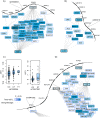Mapping of 79 loci for 83 plasma protein biomarkers in cardiovascular disease
- PMID: 28369058
- PMCID: PMC5393901
- DOI: 10.1371/journal.pgen.1006706
Mapping of 79 loci for 83 plasma protein biomarkers in cardiovascular disease
Abstract
Recent advances in highly multiplexed immunoassays have allowed systematic large-scale measurement of hundreds of plasma proteins in large cohort studies. In combination with genotyping, such studies offer the prospect to 1) identify mechanisms involved with regulation of protein expression in plasma, and 2) determine whether the plasma proteins are likely to be causally implicated in disease. We report here the results of genome-wide association (GWA) studies of 83 proteins considered relevant to cardiovascular disease (CVD), measured in 3,394 individuals with multiple CVD risk factors. We identified 79 genome-wide significant (p<5e-8) association signals, 55 of which replicated at P<0.0007 in separate validation studies (n = 2,639 individuals). Using automated text mining, manual curation, and network-based methods incorporating information on expression quantitative trait loci (eQTL), we propose plausible causal mechanisms for 25 trans-acting loci, including a potential post-translational regulation of stem cell factor by matrix metalloproteinase 9 and receptor-ligand pairs such as RANK-RANK ligand. Using public GWA study data, we further evaluate all 79 loci for their causal effect on coronary artery disease, and highlight several potentially causal associations. Overall, a majority of the plasma proteins studied showed evidence of regulation at the genetic level. Our results enable future studies of the causal architecture of human disease, which in turn should aid discovery of new drug targets.
Conflict of interest statement
Ulf Gyllensten and Stefan Enroth are authors on a patent application entitled ‘‘Determination and analysis of Biomarkers in clinical samples’’; United Kingdom Patent Application Nos. 1414913.2 and 1410956.5 (2014, Pending). Anders Mälarstig, Eric Fauman, and Daniel Ziemek are employees of Pfizer.
Figures


References
-
- Mendis Shanthi, Puska Pekka, Norrving Bo (2011) Global Atlas on cardiovascular disease prevention and control. World Health Organization; ISBN 978-92-4-156437-3.: 3–18.
-
- Gashaw I, Ellinghaus P, Sommer A, Asadullah K (2012) What makes a good drug target? Drug Discov Today 17 Suppl: S24–S30. - PubMed
Publication types
MeSH terms
Substances
Grants and funding
LinkOut - more resources
Full Text Sources
Other Literature Sources

